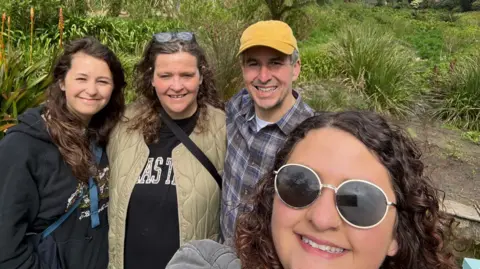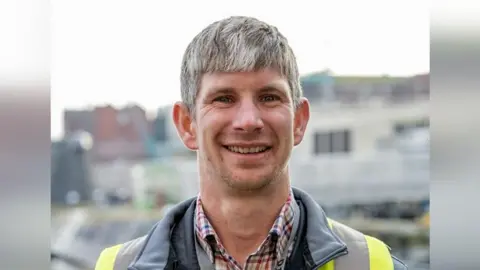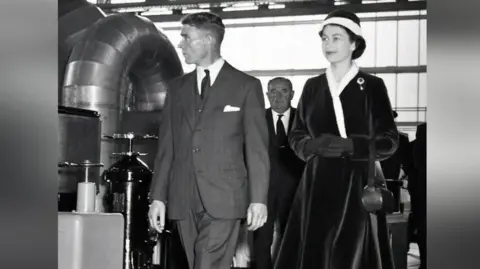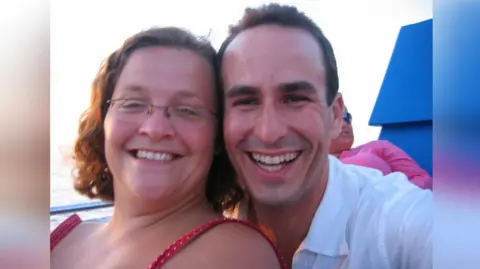Swapping city for country was 'best career move'
 Jeremy Gilmour
Jeremy GilmourThere is sometimes an assumption that the bigger the city, the better the job opportunities. But two people who left the bright urban lights for rural Cumbria speak of a very different reality.
Jeremy Gilmour was working as a quantity surveyor in his home city of Birmingham back in the early 1990s when the recession hit. The only work his employer could offer him was as a contractor at Sellafield on the west coast of Cumbria.
Although this was 200 miles up the road, and with a "pretty hideous" weekly commute, he felt he had little choice but to take it.
About 30 years on, however, he has climbed the ladder in the nuclear sector and taken part in what at the time was the biggest nuclear engineering job in Europe at the UK's most complex and challenging nuclear site.
"I don't think I would have gone near any of that if I'd stayed in the Midlands," he says.
He would have worked on "some lovely developments, some lovely office blocks, business parks or whatever" but nothing that "absolutely fascinates" him as much as what he does now.
A similar fate was written in the stars for Tim Ripper, who had dreamed of designing and testing superyachts after his degree in naval architecture in Southampton.
When he realised there was not enough demand for this he set out to find another good fit for his skills.
A keen cyclist and kayaker, he knew he wanted to live somewhere that would also afford him an outdoor lifestyle, but Cumbria had not been among his options.
 BAE Systems
BAE Systems"I was thinking, 'how do I use this degree I've got', and started to apply for various roles in naval architecture," Mr Ripper says.
"We were looking at opportunities elsewhere and we couldn't find anything really that gave us the same type of career opportunities and satisfaction, career development, that still would allow us to live close to the outdoors."
With his wife working in Manchester, he initially considered moving to North Wales but then spotted an opening to join a graduate scheme at BAE in Barrow, working on nuclear submarines.
"What was fantastic about the opportunity in Cumbria is that it gave me the ability to go an work in a shipyard in a big heavy engineering environment, but also be really close to the Lakes," he says.
With BAE and Sellafield employing more than 10,000 workers each directly, and thousands more engaged as contractors and supported through their supply chain, Cumbria plays a key role in the nuclear industry.
Mr Gilmour says it offers a wealth of opportunities he would never have had, had he stayed in his native Birmingham, despite it being the second largest city in the UK. The nature of his job, he says, means he often works on "first of a kind" projects and gets to spend time at other nuclear plants around the UK.
 NDA
NDAWhen the 58-year-old started to work at Sellafield, the Thermal Oxide Reprocessing Plant (Thorp) was being built. "At the time it was the biggest civil engineering job in Europe and back then it was worth £2bn," he says.
Thorp played a big part in Sellafield's reprocessing operations for two decades but, now the site is being decommissioned, Mr Gilmour has seen the plant's distinctive skyline change considerably.
Working on taking the iconic Windscale Piles apart, when this was never part of their design, was almost like operating in "a time capsule", he says.
The towers were built as part of Britain's cold-war nuclear efforts and their filters, installed at the last minute, played a key role in avoiding a disaster when one of them caught fire in 1957.
"The history of them is fantastic, the innovation from the 1940s to the 1950s and the things they did then were incredible," says Mr Gilmour.
 NDA
NDAMr Gilmour also made the effort of cycling up Cold Fell one Sunday morning to witness the demolition of Calder Hall's cooling towers, part of the world's first full-scale nuclear power station and a very recognizable feature on the West Cumbrian horizon.
"I saw it before you heard the explosion, because we were two or three miles away," he says.
"A puff of smoke and then we saw these cooling towers going down. It changed the skyline of the site in five minutes."
 Jeremy Gilmour
Jeremy GilmourAs much as the physical changes, Mr Gilmour has had a hand in the evolution of nuclear strategy.
He has worked with the Nuclear Decommissioning Authority (NDA) since it was created 20 years ago to oversee the clean-up of 17 nuclear sites across the country.
"I think I've probably done 10 quite different jobs during that time, all evolutions of the previous ones," he says.
Now he works as head of community and economic development at the NDA, working on projects like the soon-to-be-opened Edge in Whitehaven - a new water activity centre funded with nuclear money.
 Tim Ripper
Tim RipperThe chance of a "brilliant and varied" career was also something that encouraged Mr Ripper to settle in Cumbria. While he has been at BAE, he has worked in engineering, commissioning, operations and manufacturing, and has also spent time aboard the submarines.
His experience came full circle when the company's training academy opened in 2018 and gave him the chance to help train about 250 apprentices a year.
"Sometimes it can feel like a very out-on-a-limb part of the country but, actually, there are plenty of opportunities here - it's really exciting," he says.
 Tim Ripper
Tim RipperBecause the 39-year-old's job involves the UK's defence, there are things about it he cannot freely discuss with friends and family.
"It's not like we're poring over top secret documents and reading top secret information, but there are certain things we wouldn't be allowed to share," he says.
"People like to ask questions like how fast can a submarine go and how deep can it go and it's stuff like that, but to be honest, most people in the business aren't actually privy to that information."
He says his job provided the perfect marriage between working on submarines in a shipyard and living his best outdoor life with his wife and two children.
The family live in Eskdale - in the heart of the Lake District - and Mr Ripper says he loves to have the opportunity to take the children camping and walking whenever he wants.
 Jeremy Gilmour
Jeremy GilmourMr Gilmour is also hooked on the "incredible scenery" but, coming to Whitehaven from landlocked Birmingham, there is something else he would find hard to give up.
"As a Midlander born and bred I still find seeing the sea every day just great," he says. "On a nice day there is just no better place to be."
He and Mr Ripper have both found niche job satisfaction and a rural lifestyle they would not have had without moving to Cumbria.
But Mr Gilmour discovered something else important in the county.
When he arrived at Sellafield his wife, Joanne, was working in the office next door.
